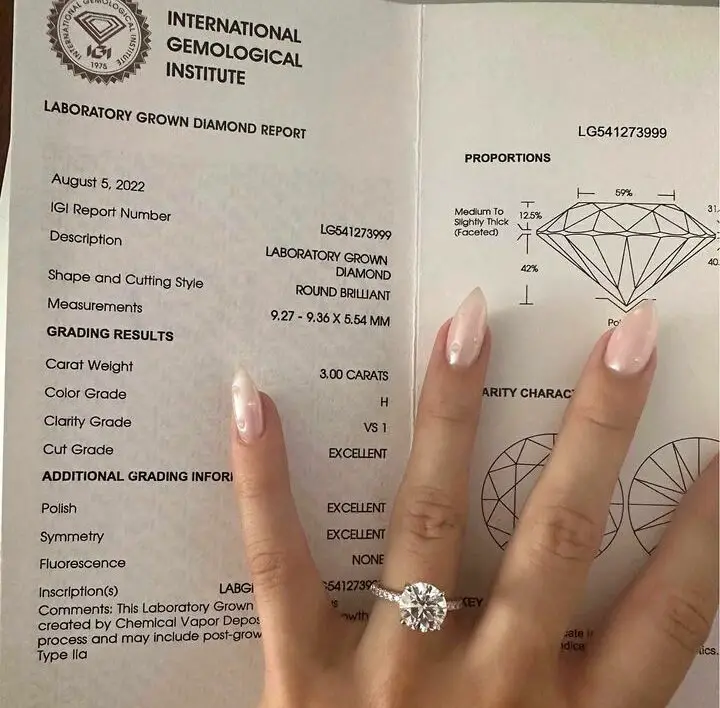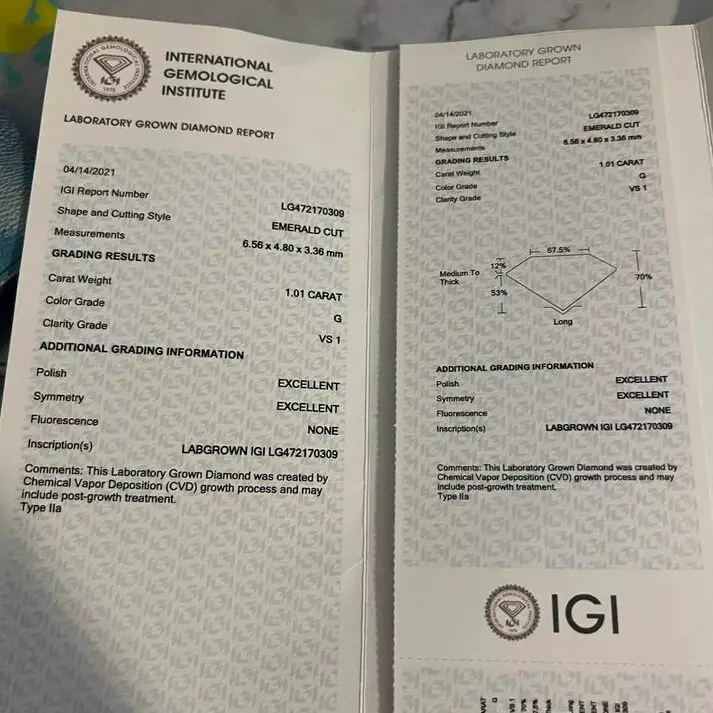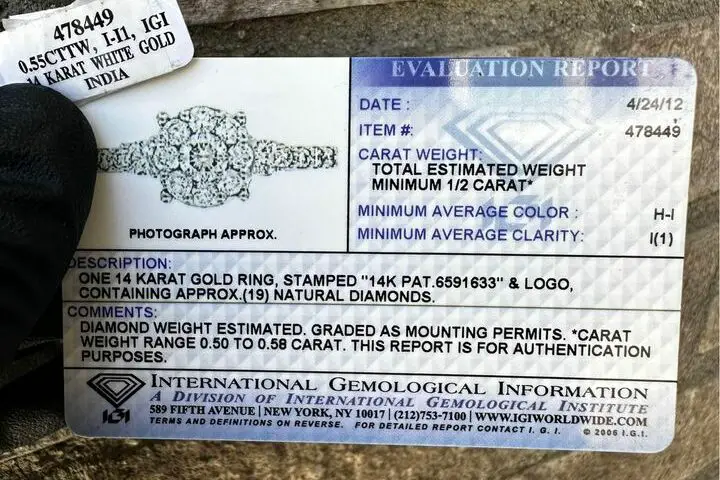How do you know you are getting a high quality diamond and fair price? Can you trust what jewelry retailers claim about their diamonds? This is where diamond certification comes in.
A diamond certificate, also referred to as a diamond grading report, provides the quality credentials and verification you need when buying diamonds. Receiving an unbiased assessment of the 4Cs and other characteristics from a trusted gemological lab gives you assurance that the diamond you select lives up to your expectations.
Read on to learn all about diamond certification and why it should be an essential part of your diamond buying journey.
What is Diamond Certification?
Diamond certification refers to the process by which gemological laboratories analyze, grade, and issue reports certifying the quality of diamonds. Also called diamond grading reports, these certificates are like a diamond’s birth certificate. They provide standardized documentation of a diamond’s specifications as objectively determined by experts using scientific methods and instrumentation.
Diamond grading involves assessing the diamond under 10x magnification for clarity characteristics, taking precise measurements to determine carat weight and cut angles, and comparing the stone to master color comparison stones to derive a color grade. This data is recorded on the certificate along with identifying details and the lab’s logo. The detailed quality assessment is encapsulated in the diamond’s 4Cs grading—cut, color, clarity, and carat weight.
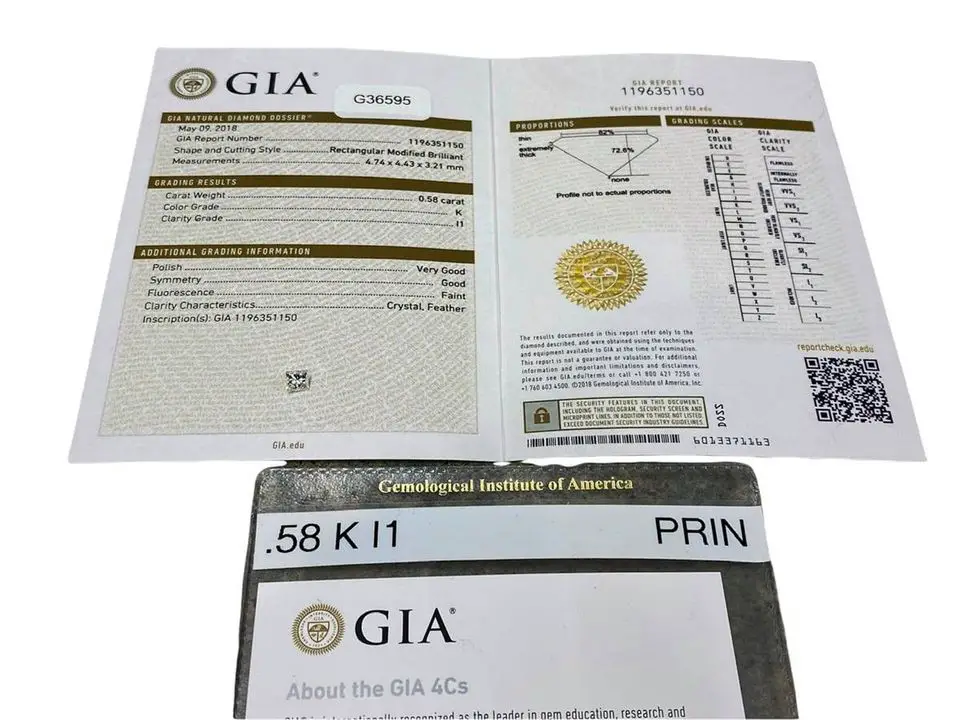
Diamond certificates are not issued by jewelers or sellers. Instead, stones are sent to independent, third-party gem labs where they are graded by experienced specialists. Since the labs have no vested interest in assigning one grade over another, diamond certificates are unbiased and trusted reports. Certification assures buyers that the quality grades claimed are accurate and that the diamond is a natural gemstone, not a synthetic diamond made in a lab.
Importance of Diamond Certification
Diamond certification offers many benefits that together provide buyers with confidence about a diamond’s authenticity and value. Here are some of the key reasons diamond certification is so important:
- It provides assurance the diamond’s quality lives up to claims made by sellers. The characteristics are verified by experts, not just stated by vendors trying to make a sale.
- Certification confirms the diamond is a natural gemstone, not a lab-grown synthetic. Labs detect treatments and artificial growth.
- The diamond can be conclusively identified in the future based on the report number engraved on its girdle.
- Grading reports allow buyers to accurately compare similar certified diamonds from different vendors.
- The objective quality assessment establishes the diamond’s true market value.
- Certification acquired when the diamond is graded provides permanent record of the specifications. The lab keeps copies for verification purposes.
- Buyers have recourse if a diamond is misrepresented, with certification documenting the deficiencies.
While appraisals also provide diamond valuations, certificates focus specifically on quality grading. Together, they offer a complete picture of the diamond’s characteristics that impact value.
Diamond certification does come at an additional cost on top of the diamond’s price. On certificates from leading labs like GIA and AGS, you can expect to pay around $100-$250 depending on the diamond’s size.
Given that diamonds are a significant investment, the cost is worthwhile for the peace of mind, especially for higher quality and size diamonds. Keep in mind that certification costs are a drop in the bucket compared to the diamond’s overall value.
Types of Diamond Certification
Not all diamond grading reports are equal. There are several major international gem laboratories that issue diamond certificates, with some differences in their methods, grading scales, and overall reputation. Here are the world’s most prominent diamond grading labs:
GIA
The Gemological Institute of America is regarded as the world leader in gemology and diamond grading. The GIA pioneered the first diamond grading standards in the 1950s. Many consider the GIA’s word to be the authority in diamond quality assessment.
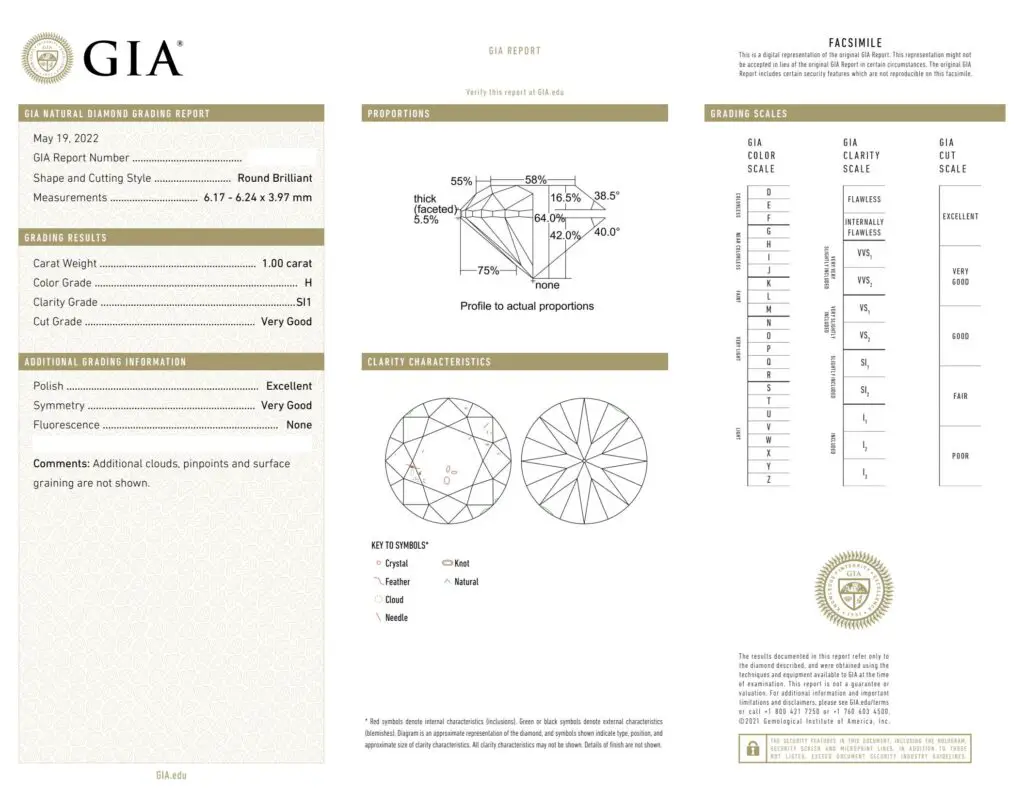
AGS
The American Gem Society is a well-respected organization of jewelers that adheres to high ethical standards. The AGS lab issues certificates with extremely detailed evaluations.
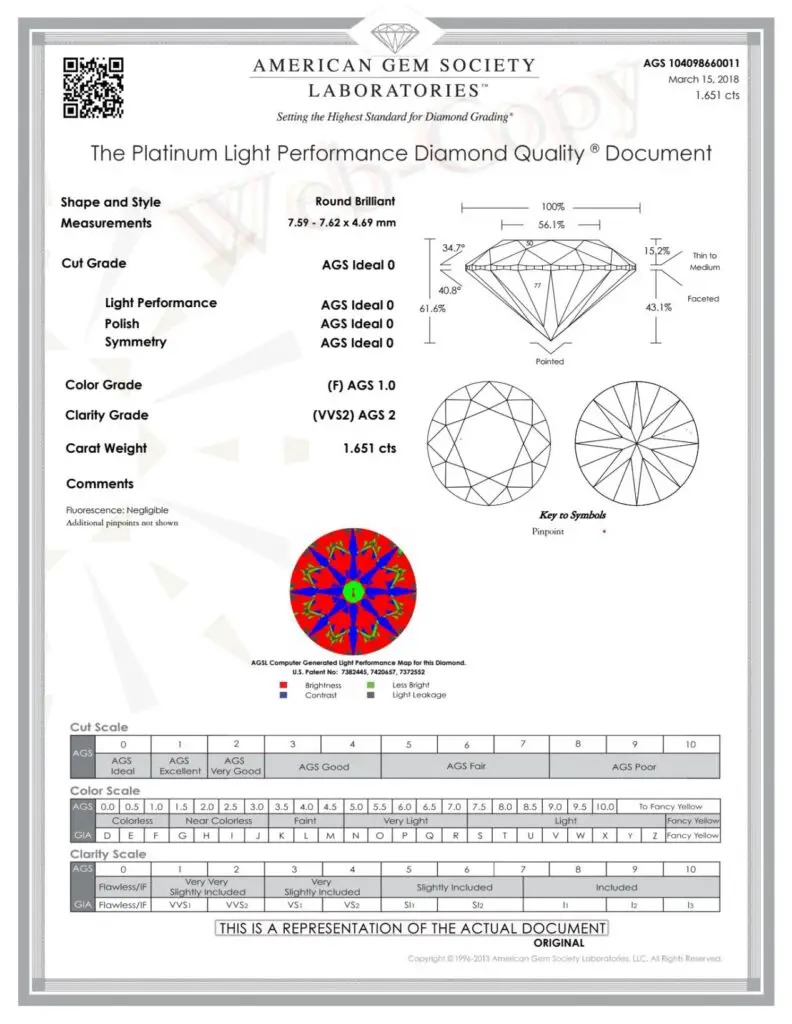
EGL
The European Gemological Laboratory has labs around the world. EGL grading criteria is considered slightly less stringent than GIA. Clarity grades are sometimes one step higher than GIA’s opinion. There are also EGL USA and EGL International branches with varying reputations.
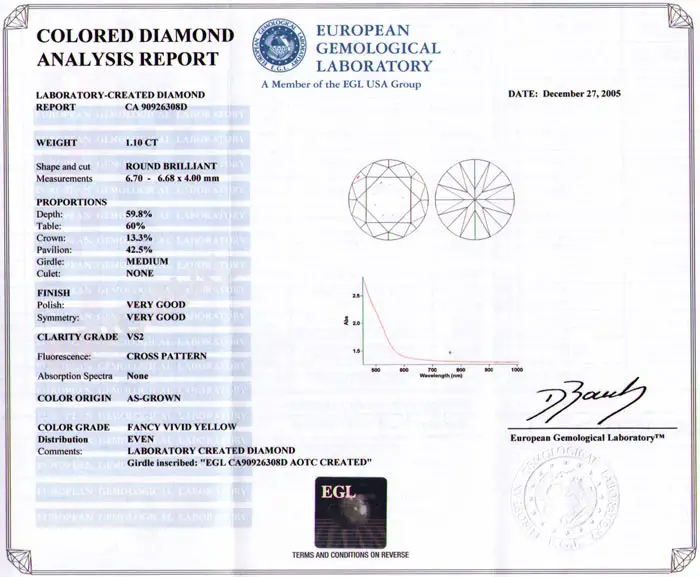
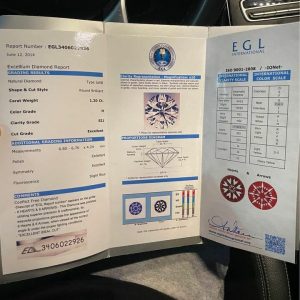
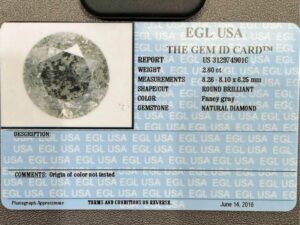
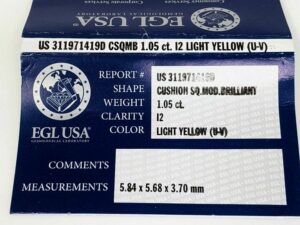
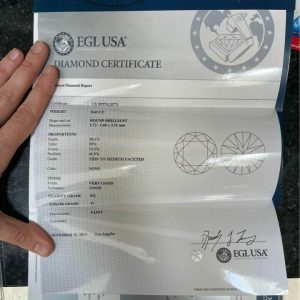
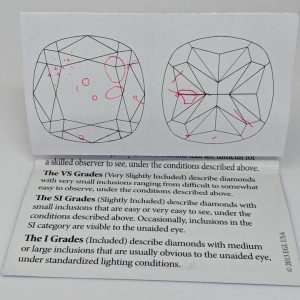
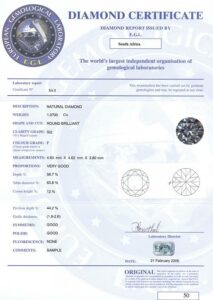
IGI
The International Gemological Institute has labs in major diamond centers like Antwerp and New York. It is one of the largest gem certification groups, though not as widely-recognized as GIA.
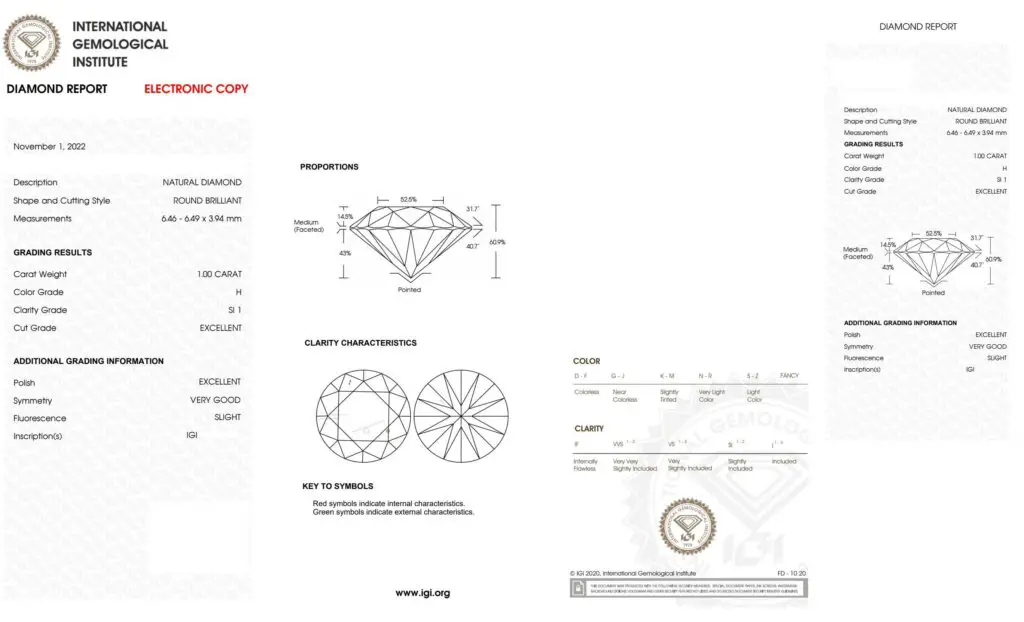
HRD Antwerp
Based in one of the world’s diamond capitals, the HRD Antwerp Gemological Laboratory grades many of Europe’s diamonds. Grading tends to be somewhat less conservative than GIA.
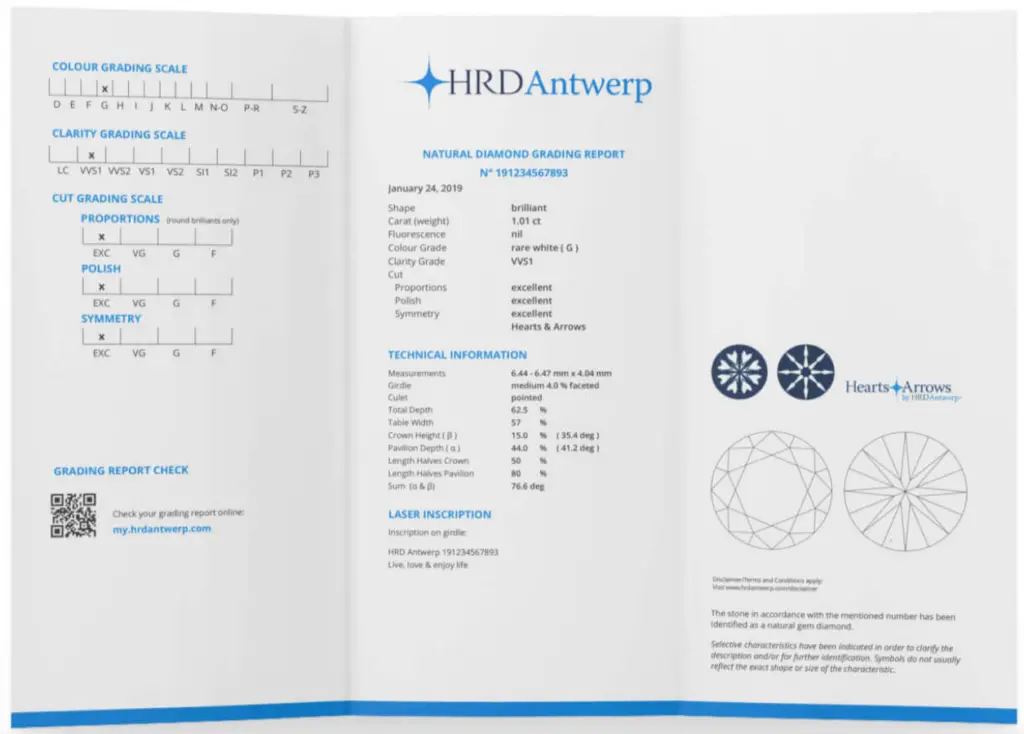
While other smaller laboratories exist, these are by far the dominant choices for diamond certification. On the whole, GIA and AGS are viewed as setting the highest standards and being the most meticulous. Always make sure to use a reputable lab that adheres to uniform, consistent methods for grading.
Comparison Table of Major Diamond Certification Labs:
| Lab Name | Reputation | Grading Standards | Cost Range | Turnaround Time |
|---|---|---|---|---|
| GIA | Excellent | Strict | $85-$460 | 2-3 weeks |
| AGS | Excellent | Strict | $65-$350+ | 1-2 weeks |
| EGL | Good | Slightly lenient | $75-$250 | 2-4 weeks |
| IGI | Good | Respectable | $75-$250 | 2-3 weeks |
| HRD Antwerp | Good | Somewhat lenient | $80-$300+ | 2-4 weeks |
What is Included on a Diamond Grading Report?
Diamond grading reports contain a wealth of technical information that documents the stone’s characteristics. The specific report format differs slightly between labs, but the type of information is largely the same.
Here are the key elements to look for on a diamond certificate:
- Header with report number, date, and lab logo
- Grading results for diamond shape, measurements, weight, clarity, color, and cut grade
- Graphic representation of the diamond
- Culet size, polish, and other comments
- Clarity plot mapping inclusions
- Cut proportions like table %, depth %, etc.
- Comments on finish like polish and symmetry
- Grading methodology and lab signatures
- Identification number and unique inscription on the diamond’s girdle
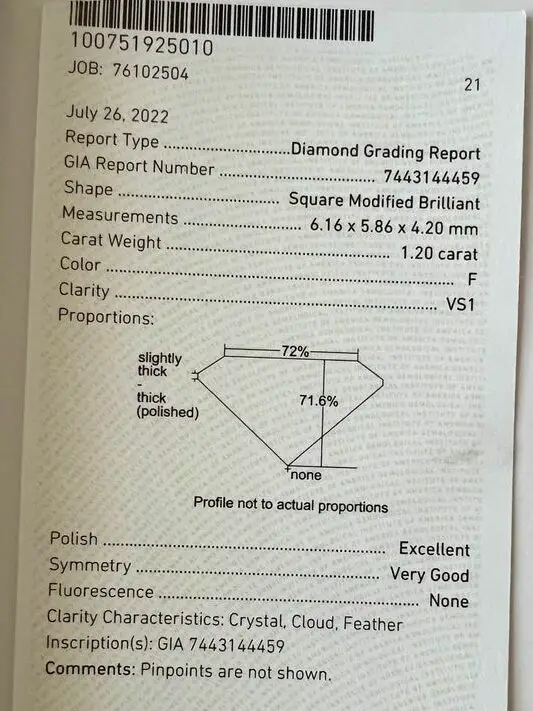
Diamond certificates log all the pertinent details that factor into a diamond’s grading and value. However, it does not spell out a monetary value. Most buyers rely on both diamond certification and gemologists’ appraisals to arrive at a fair valuation and price. By thoroughly documenting quality, the certificate allows appraisers to give accurate diamond valuations as well.
Certification vs. Appraisal
Since both diamond certificates and appraisals examine the diamond’s characteristics, buyers are sometimes confused about the difference between the two. The main distinction lies in their end goals.
A diamond grading certificate focuses exclusively on analyzing and documenting qualities about the diamond. It applies standardized methods for classification and grading as verified by the issuing lab. The final report describes the diamond’s attributes but does not proclaim an explicit monetary value.
A diamond appraisal also details the stone’s properties, with the aim of assigning a valuation and fair market price. Most appraisers rely heavily on the specifications noted on the certificate. The appraiser’s expertise comes into play for interpreting the characteristics and how they influence value compared to market trends.
Diamond Appraisal Examples:
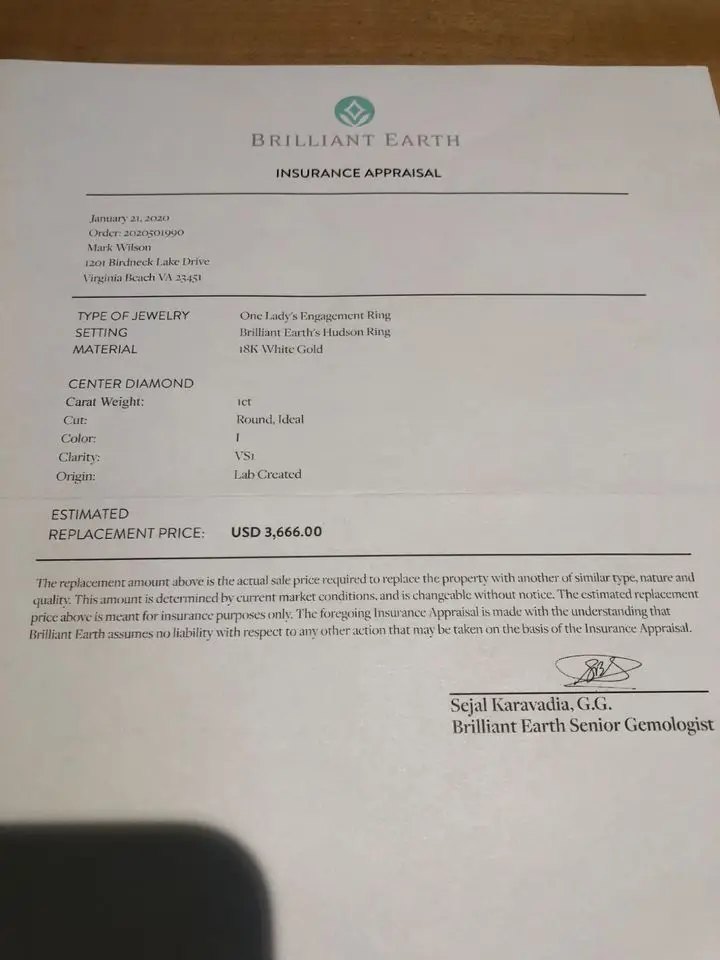
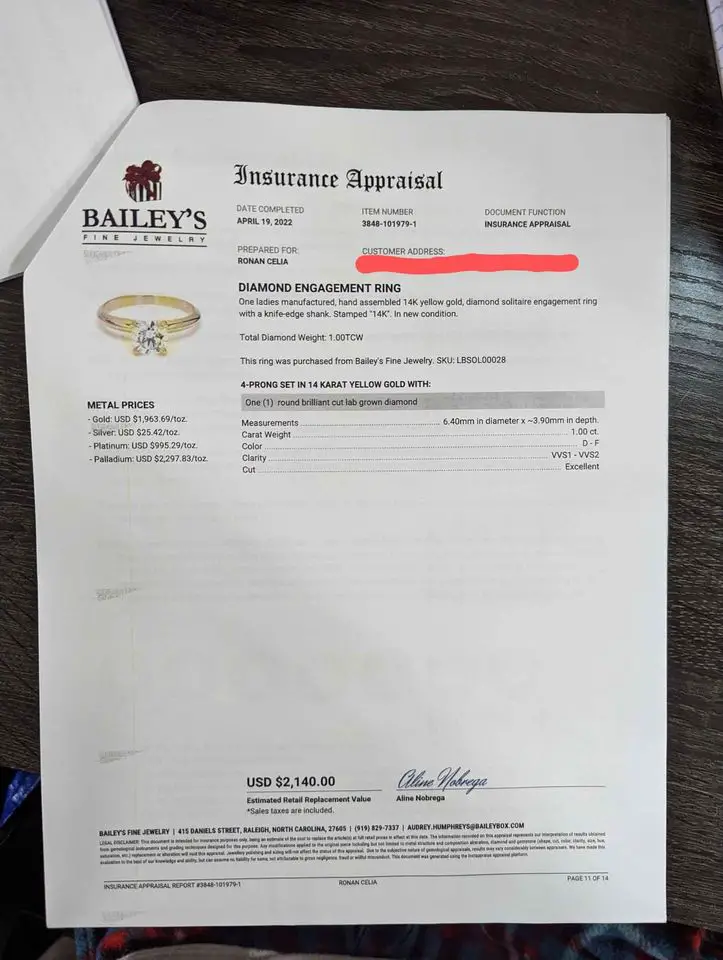
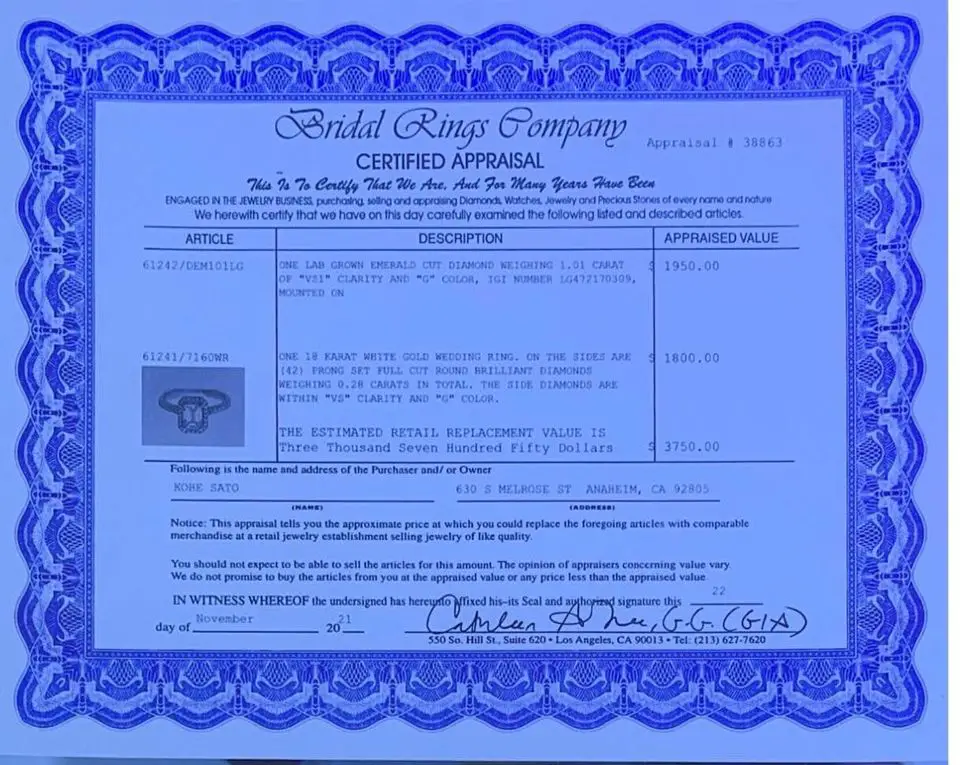
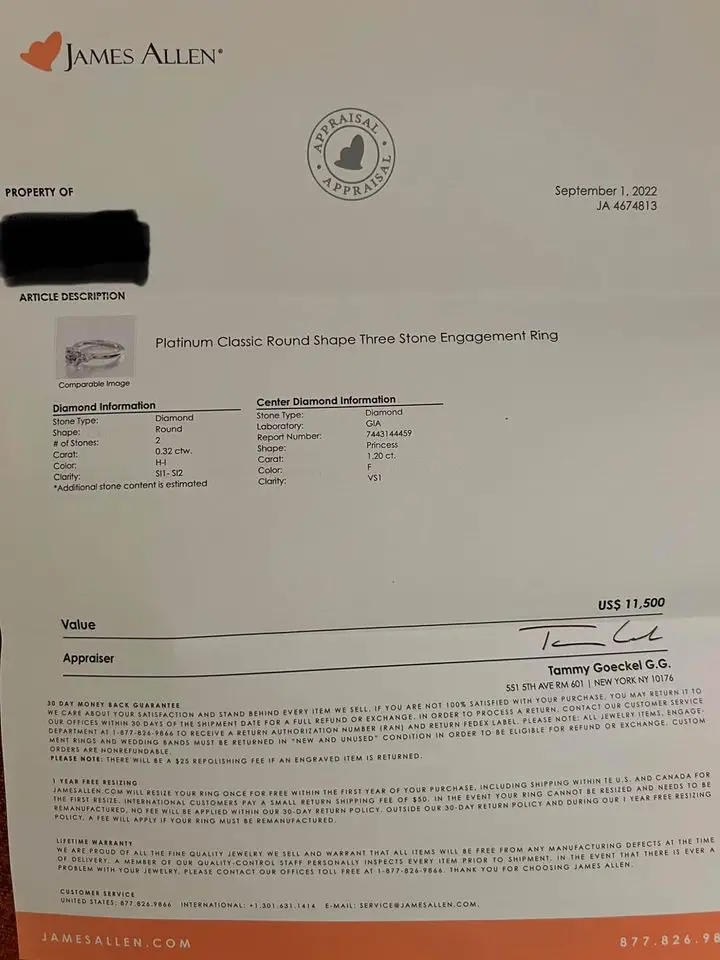
Certification vs. Appraisal Comparison Table:
The following table highlights the differences between diamond certification and appraisals.
| Aspect | Diamond Certification | Diamond Appraisal |
|---|---|---|
| Purpose | Grading and documentation of quality. | Valuation and determination of market value. |
| Focus | Objective assessment of diamond characteristics. | Subjective assessment of value and worth. |
| Monetary Value | Does not assign a monetary value to the diamond. | Provides a monetary value for the diamond. |
| Reliance on Data | Primarily relies on objective data and grading. | Combines data with appraiser’s expertise. |
| Use for Insurance | Used for insurance purposes based on quality. | Used for insurance purposes based on valuation. |
Diamond certificates and appraisals complement each other. Certification provides the raw data about the stone. Valuation builds on that objective data with subject matter expertise to gauge the diamond’s worth. Some gems labs offer a combination certification and appraisal document. But most buyers obtain separate reports for the grading and valuation.
Benefits of Buying a Certified Diamond
Given the large sums involved in buying diamonds, certification provides benefits that help ensure your investment is a wise one. Here are some of the top advantages of purchasing a certified diamond:
- Confidence the diamond is genuine and not an imitation.
- Verification that the diamond’s quality lives up to the grades stated by the seller.
- Diamonds can be accurately compared to find the best value based on gradings.
- Recognition of the diamond’s market value from an independent authority.
- Assurance about the diamond’s identifying details, which is recorded with the lab.
- Documentation of the diamond’s credentials, which can be used for insurance purposes.
- Ability to gain recourse if the diamond’s characteristics are misrepresented.
- Potential to increase the diamond’s worth and liquidity when it comes time to sell.
- Higher level of trust in retailers that deal exclusively in certified diamonds.
While certification comes with fees ranging from 1-5% of the diamond’s cost, the benefits far outweigh the extra expense. Ultimately, buyers gain the security of knowing exactly what they are buying with a certified diamond.
Benefits of Certified Diamonds Table:
| Benefit | Description |
|---|---|
| Assurance of Authenticity | Verification that the diamond is genuine. |
| Quality Confirmation | Verification that the diamond’s quality matches claims. |
| Accurate Comparison | Ability to compare diamonds based on standardized grades. |
| Market Value Estimation | Determination of the diamond’s market value. |
| Identifying Details Documentation | Recording of key identifying details for future use. |
| Recourse in Case of Misrepresentation | Legal recourse with documented deficiencies. |
| Increased Value and Liquidity for Resale | Enhanced resale potential due to certification. |
Where to Buy Certified Diamonds
For the best selection of certified diamonds, look to retailers that specialize in selling graded stones accompanied by reports from respected labs like GIA and AGS. Several reputable online diamond vendors fall into this category, including:
- James Allen – Offers 360-degree videos and idealscope images of diamonds.
- Blue Nile – Huge selection of GIA and AGS certified diamonds sold online.
There are also many high-end brick-and-mortar jewelry stores that primarily or exclusively sell diamonds accompanied by reports from major gem labs. This includes stores like:
- Tiffany and Co.
- Helzberg Diamonds
- Robbins Brothers
- Whiteflash
A key tip when buying certified diamonds is to verify that the diamond you receive matches the one described on the certificate. Do this by checking that the certification number inscribed on the diamond’s girdle corresponds to the report number. Reputable retailers will allow you to confirm this before committing to the purchase.
Purchasing through custom designers and jewelers is another avenue to buy certified loose diamonds or have them incorporated into finished pieces. Many designers work hand-in-hand with certification laboratories and have direct access to graded stones. They can help source diamonds that live up to your budget and expectations.
Cost of Diamond Certification
Cost Comparison Table Based on Carat Weight:
How the certification cost varies with the carat weight of the diamond for the major labs.
| Carat Weight (ct) | Certification Cost (GIA) | Certification Cost (AGS) |
|---|---|---|
| 0.5 | $85 | $65 |
| 1.0 | $200 | $250 |
| 2.0 | $350 | $350+ |
So how much does diamond certification cost? Grading fees vary depending on the lab issuing the report. Each lab has their own fee structure based on the diamond’s carat weight. As a general rule, costs are lowest for smaller diamonds and increase progressively for larger stones.
Here are some examples of typical fees at popular labs:
GIA certification fees start around $85 up to 1 carat, then go up to $460 for a diamond over 10 carats. The rate is about 1.1% of total cost for a 1 carat diamond.
AGS lab certification costs range from $65 to around $350+ based on carat weight, or about 1% of a 1 carat diamond’s total price.
EGL and IGI certification prices fall between $75 to $250 for a 1 carat stone, averaging 1-1.5% of the full diamond cost.
Other services like laser inscription of the diamond’s ID on the girdle and express turnaround sometimes come with added costs. Overall, reputable certification costs around 1-3% of the total diamond’s value depending on the lab.
How to Read a Diamond Certificate
Learning how to decipher the key sections and information on a diamond certificate takes some practice. But it is an important skill so you understand exactly what the quality grades mean.
Here are some tips:
- Look at the shape and physical dimensions like length, width, and depth measurements to verify the diamond matches the plotted outline.
- Check that the carat weight matches what you expected. Remember the stated weight is very precise based on technical measurement.
- Examine the clarity grade and refer to the plotted diagram to see inclusions mapped in the stone. A VS2 may have minor inclusions hard to spot with the naked eye.
- Make sure the color grade aligns with your expectations. Know that each grade step is subtle, but D to H grades are noticeably more yellow.
- Read the comments on polish, symmetry, and other details influencing the diamond’s appearance.
- Pay attention to the cut grade and proportions which affect the diamond’s sparkle. Performance grades like Excellent or Very Good indicate optimal light return.
- Review the unique IGI or GIA report number and look for the matching laser-inscribed number on the diamond’s girdle.
Invest time upfront learning to analyze key parts of diamond certificates. Being able to interpret the quality ratings and details empowers you to make informed decisions.
Diamond Certification FAQs
Let’s review answers to some of the most frequently asked questions about diamond certification and grading reports:
What’s the difference between GIA and other diamond certifications?
The GIA, or Gemological Institute of America, is considered the pioneers of diamond grading and the most stringent lab. AGS has comparable expertise and validity. Other prominent labs like EGL also offer respected reports but may have slightly more leniency in grades. Always check a lab’s reputation to be sure.
Do I need diamond certification if I trust the jeweler I’m buying from?
Yes, diamond certification is still recommended even if you have a trusted relationship with the jeweler. Certificates give an unbiased perspective of quality. This allows you to confirm a diamond lives up to the 4Cs grades and value you are paying for.
What diamond certifications guarantee the grade is accurate?
Reputable diamond labs with stringent grading practices like GIA and AGS provide assurance that a diamond’s stated grade is accurate. While no certification is foolproof, these labs certify diamond quality you can count on for integrity.
How much does GIA or AGS certification cost?
The cost depends on the carat weight. Under 1 carat, you’ll pay $80-$150. For a 1 carat diamond, certification costs around $200-$250 for both GIA and AGS. Fees are a small fraction of a diamond’s total cost.
What should I look for when reading a diamond certificate?
Pay attention to the 4Cs grades, specifically clarity, color, and cut quality. Review the quality characteristics in the comments. Confirm the measurements match the outlined shape. Read the certification number on the diamond itself.
Does certification affect diamond pricing and value?
Yes, certification is key for determining true market value. A diamond will be priced significantly higher with a GIA or AGS report stating top grades compared to a lower-tier lab. Higher grades increase value within the same lab as well.
The Takeaway on Diamond Certification
A diamond certificate provides a science-based quality assessment you can count on. By certifying diamonds with consistent processes and trained experts, gemological labs empower consumers to make informed decisions about their diamond purchases. While no lab is perfect, high standards from GIA, AGS, and others make diamond certification extremely reliable.
Seeking out a certified diamond gives you the security of knowing the diamond’s quality and characteristics match the grading report. Check that the diamond seller provides certification from a reputable lab to verify what you are buying. Review the key sections of the certificate as well to understand the diamond’s credentials.
Diamond certification services are readily available today from trustworthy labs situated around the world. There are also more options than ever to buy certified diamonds, both online and locally. While the process adds some cost, consider it a worthwhile investment in protecting your purchase. In the end, you can proceed with confidence and peace of mind.
